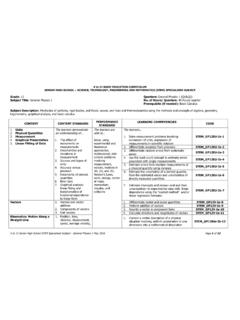Transcription of UNIT 61: ENGINEERING THERMODYNAMICS
1 1 unit 61: ENGINEERING THERMODYNAMICS unit code: D/601/1410 QCF level: 5 Credit value: 15 Students studying this unit should be sure that they can determine the various properties of fluids. If you are already able to do this you should skip this tutorial. TUTORIAL No. 1 PRE-REQUISITE STUDIES FLUID PROPERTIES INTRODUCTION Before you study the four outcomes that make up the module, you should be competent in finding the properties of liquids, gases and vapours. If you are already competent in this, you should skip this tutorial. This tutorial is designed to teach you the basic concepts of THERMODYNAMICS and the properties of fluids. On completion of this tutorial you should be able to the following.
2 Use the correct thermodynamic symbols. Determine the properties of a gas. Determine the properties of vapours. Determine the properties of liquids. We will start by examining the symbols used. 2 1. SYMBOLS The symbols used throughout in these tutorials are (International System). These are not always the ones used by the examiner. These are the main Symbols. The also recommends the use of / to mean divide rather than the use of negative indices favoured by examiners. For example ms-1 becomes m/s. Quantity units Derived unit symbol Length m various Mass kg m Time s t Volume m3 V or Q Specific Volume m3/kg v Volume Flow Rate m3/s Density kg/m3 Force kg m/s2 N F Weight kg m/s2 N W Pressure Head m h Altitude m z Area m2 A Speed of Sound m/s a Specific Heat Cap.
3 N m/kg K Joule/kg K c Energy N m Joule Enthalpy N m Joule H Internal Energy N m Joule U Specific Enthalpy N m/kg J/kg h Specific Int. Energy N m/kg J/kg u Mass flow rate kg/s Polytropic Index n Adiabatic Index Pressure N/m2 Pascal p Heat Transfer N m Joule Q Work N m Joule W Heat Transfer Rate N m/s Watt Work Rate (power) N m/s Watt P Char. Gas Const N m/kg K J/kg K R Universal Gas Constant J/kmol K Ro Entropy J/K S Specific Entropy J/kg K s Absolute Temperature K T Celsius Temperature oC Velocity m/s2 v or u Dynamic Viscosity N s/m2 Pa s or Kinematic Viscosity m2/s Now we will examine the basic concepts required to do this tutorial successfully.
4 3 2. BASIC CONCEPTS Throughout these tutorials you will use properties which are either EXTENSIVE or INTENSIVE. An extensive property is one which is divisible. For example Volume when divided by a number becomes smaller. Other examples are mass and energy. An intensive property is a property of a mass which remains the same value when the mass is divided into smaller parts. For example the temperature and density of a substance is unchanged if it is divided into smaller masses. Throughout the tutorials you will use TOTAL and SPECIFIC quantities which relate only to extensive properties. A total quantity is always denoted by a higher case letter such as V for volume (m3) and H for enthalpy (J).
5 A specific quantity represents the quantity per kg and is obtained by dividing the property by the mass. Such properties are always designated by lower case letters such as v for specific volume (m3/kg) and h for specific enthalpy (J/kg). Specific volume is mainly used for gas and vapours. The inverse of specific volume is density ( ) (kg/m3) and this is mainly used for liquids and solids but also for gases. Note =1/v. Because the same letters are used to designate more than one property, often alternative letters are used. For example v for specific volume may occur in the same work as v for velocity so often u or c is used for velocity. h is used for height, head and specific enthalpy so z is often used for height instead.
6 The unit of Force and Weight is the kg m/s2. This comes from Newton's Second Law of Motion (Force = mass x acceleration). The derived name for the unit is the Newton. In the case of Weight, the acceleration is that of gravity and in order to convert mass in kg into weight in Newtons, you must use W = mg where g is normally m/s2. Now we will examine forms of energy a fluid may have. 4 3. ENERGY FORMS A fluid may possess several forms of energy. All fluids possess energy due to their temperature and this is called INTERNAL ENERGY. All possess GRAVITATIONAL or POTENTIAL ENERGY due to their elevation relative to some datum level. If the fluid is moving it will possess KINETIC ENERGY due to its velocity.
7 If it has pressure then it will possess FLOW ENERGY. Often pressure and temperature are the main two governing factors and we add internal energy to flow energy in order to produce a single entity called ENTHALPY. Let us look at each in more detail. GRAVITATIONAL or POTENTIAL ENERGY In order to raise a mass m kg a height z metres, a lifting force is required which must be at least equal to the weight mg. The work done raising the mass is as always, force x distance moved so Work = mgz Since energy has been used to do this work and energy cannot be destroyed, it follows that the energy must be stored in the mass and we call this gravitational energy or potential energy There are many examples showing how this energy may be got back, a hydro-electric power station.
8 = mgz KINETIC ENERGY When a mass m kg is accelerated from rest to a velocity of v m/s, a force is needed to accelerate it. This is given by Newton's 2nd Law of Motion F= ma. After time t seconds the mass travels x metres and reaches a velocity v m/s. The laws relating these quantities are a = v/t and x = vt/2 The work done is W = Fx = max = mv2/2 Energy has been used to do this work and this must be stored in the mass and carried along with it. This is KINETIC ENERGY. = mv2/2 5 FLOW ENERGY When fluid is pumped along a pipe, energy is used to do the pumping. This energy is carried along in the fluid and may be recovered (as for example with an air tool or a hydraulic motor).
9 Consider a piston pushing fluid into a cylinder. The fluid pressure is p N/m2. The force needed on the piston is F= pA The piston moves a distance x metres. The work done is W = Fx = pAx Since Ax =V and is the volume pumped into the cylinder the work done is W = pV Since energy has been used doing this work, it must now be stored in the fluid and carried along with it as FLOW ENERGY. = pV INTERNAL ENERGY This is covered in more detail later. The molecules of a fluid possess kinetic energy and potential energy relative to some internal datum. Usually this is regarded simply as the energy due to the temperature and very often the change in internal energy in a fluid which undergoes a change in temperature is given by U = mc T The symbol for internal energy is U kJ or u kJ/kg.
10 Note that a change in temperature is the same in degrees Celsius or Kelvin. The law which states internal energy is a function of temperature only is known as JOULE'S LAW. ENTHALPY When a fluid has pressure and temperature, it must possess both flow and internal energy. It is often convenient to add them together and the result is ENTHALPY. The symbol is H kJ or h kJ/kg. H = + U Next you need to study the properties of fluids and the laws relating them. 6 4 GAS LAWS In this section you will do the following. Derive basic gas laws. Examine the characteristic gas law. Examine the universal gas law. Define the mol. Solve gas law problems. THEORY A gas is made of molecules which move around with random motion.













